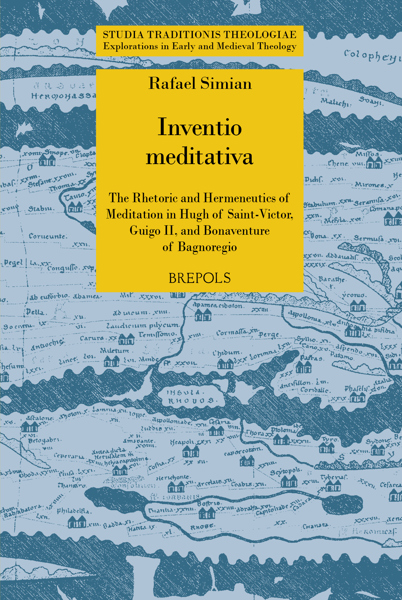
Inventio meditativa
The Rhetoric and Hermeneutics of Meditation in Hugh of Saint-Victor, Guigo II, and Bonaventure of Bagnoregio
Rafael Simian
- Pages: 269 p.
- Size:156 x 234 mm
- Language(s):English
- Publication Year:2024
- € 70,00 EXCL. VAT RETAIL PRICE
- ISBN: 978-2-503-61267-6
- Paperback
- Available
- € 70,00 EXCL. VAT RETAIL PRICE
- ISBN: 978-2-503-61268-3
- E-book
- Available
A new conceptual framework for late-medieval meditation and the Christian religion in the works of Hugh of Saint-Victor, Guigo II, and Bonaventure of Bagnoregio.
"Simian’s Inventio meditativa is a learned close reading of three medieval authors. It is clear from his book that Simian is deeply knowledgeable about medieval theological texts from late antiquity to the early modern period. But what is most lovely about Simian’s book is his fierce defense of medieval "openness"--that, contrary to the misconception that medieval people conceived of reality as "a God-given, fixed metaphysical order" and therefore only pursued "univocity" (221), medieval people in fact relied on tradition in order to actively cultivate new knowledge and moral virtue." (Lauren Mancia, in The Medieval Review, 25.10.46, October 2025)
"What is most helpful here is Simian’s argument that Late Antique inventio is medieval meditatio. This helps to show that meditation was not a mere intellectual exercise where the meditator was simply chewing the cud to discern the one meaning embedded in the text. Rather, meditation was a much livelier practice wherein the meditator was adding to the meaning. (…) Simian reminds us that medieval texts are richer than expected, not merely museum pieces waiting to be read but living texts whose meanings need to be discovered. As "open works" they will continue to repay their readers and meditators richly." (Greg Peters, in Comitatus: A Journal of Medieval and Renaissance Studies, 56, 2025, p. 274-276, https://doi.org/10.1353/cjm.2025.a972560)
Rafael Simian (PhD) is Assistant Professor in the Philosophy Department at Universidad San Sebastián (Chile). His research focuses on medieval and early modern thought, especially the intersection between philosophy, theology, and rhetoric. He has published articles on Hugh of Saint-Victor, Guigo II, Thomas Aquinas, and Descartes among other historical figures. At present, he is working on a Spanish translation of Descartes’ Meditationes de prima philosophia.
The present volume develops a new conceptual perspective on late-medieval meditation, particularly in Hugh of Saint-Victor, Guigo II, and Bonaventure of Bagnoregio. For the most part, modern commentaries on the subject have relegated rhetoric to the margins of attention, if not to complete silence. In contrast, this book contends that these writers arrived at their distinctive conceptions of meditation by drawing from the Ciceronian rhetorical tradition. They did so by deepening earlier rhetorical treatments of inventio while adapting them to the Christian life. The examination of this topic is divided into three principal and related aspects. First, meditation is studied as a rhetorical notion for a specific kind of mnemonic, rational, and affective exercise. Second, that notion is used to shed light on meditation as a compositional textual practice whose outcomes bear striking analogy to what Umberto Eco called the ‘open works’ of the Western avant-garde. Finally, meditation emerges as a form of literary reception required for approaching and construing certain works. In exploring each of these aspects, the study shows that rhetoric radically informs, not only Hugh’s, Guigo’s, and Bonaventure’s engagement with meditation, but also their views on salvation history, monastic life, divine revelation, scientific learning, and biblical hermeneutics. Thus, despite the omission or relative insignificance of the ars bene dicendi in most modern investigations, it is argued that rhetoric lies at the core of these authors’ entire religious outlook. In this way, the present volume aims to contribute to a better understanding of these medieval figures by filling an important gap in the scholarly literature.
Preface
Introduction
Chapter 1: The Practice of Meditation in Hugh of Saint-Victor’s Didascalicon and Its Hermeneutical Consequences
1. The Reason for Scientific Study: Its Organization, Order, and Method
2. The Education of Memory as Method for Textual Study
3. Unifying the Spirit through Memory
4. Meditation and Mnemonic Invention
4.a. Ancient, Medieval, and Hugonian Meditation
4.b. Meditation as Rhetorical Invention
4.c. Unifying the Spirit through Meditation
5. Final Remarks: Hugh’s Rhetorical Outlook on Learning and the Christian Life
Chapter 2: Meditation and Hermeneutic Openness in Guigo II: The Scala Claustralium and the First Meditation
1. Guigo II and the Practice of Meditation
2. Openness in the First Meditation and the Biblical Form of Writing
3. The First Meditation: Humiliation, Meekness, and Silence
4. Final Remarks: Rhetoric, Meditation, and Openness in Guigo II
Chapter 3: Ecclesial Memory, Meditation, and Hermeneutic Openness in Bonaventure of Bagnoregio
1. The Practice of Meditation and Its Place in Christian Life
1.a. Meditation in Bonaventure’s Writings
1.b. Meditation and Ecclesial Progress
2. The Literary Strategy and Openness of the Itinerarium
3. Existing, Living, Discerning: The Rational Ascent to God
3.a. The Function of the Passage and Its Two Empty Spaces
3.b. The Triad and Ascent in Augustine
3.c. The Triad and Ascent in Dionysius
3.d. Vegetative Life and the Itinerarium’s Inexhaustibility
4. The Openness and Depth of the Itinerarium
5. Final Remarks: Seneca’s Bees as Models for Reading and Meditation
Epilogue
Appendix 1: On the Hermeneutic Reflexivity of Hugh’s Didascalicon
Appendix 2: Translation, Annotation, and Division of Guigo’s First Meditation
Bibliography
Index




